|
|
|
 |
 |
 |
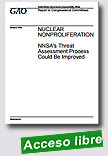 |
Nuclear Nonproliferation: NNSA's Threat Assessment Process Could Be Improved
Government Accountability Office (GAO-US), October 30 2015, 40 p.
The threat posed by the proliferation of nuclear and radiological weapons remains one of the most pressing U.S. national security challenges, and these threats are evolving. Information produced by the OTH initiative about future proliferation threats is intended to support long-term DNN planning and other DNN management decisions.
|
The Joint Explanatory Statement Accompanying the National Defense Authorization Act for Fiscal Year 2014 includes a provision for GAO to assess NNSA's nuclear nonproliferation programs. This report (1) describes how NNSA assessed potential proliferation threats through its OTH initiative and assesses the limitations, if any, in the process used by the initiative and (2) examines the extent to which NNSA used information about the potential threats assessed through the OTH initiative in DNN organization and planning decisions.
GAO analyzed NNSA documentation on the OTH initiative and NNSA planning documents. GAO also interviewed DOE and NNSA officials, DOE national laboratory representatives, and external subject matter experts and external validators in peer review groups involved in OTH activities.
Highlights Page
Extraído de: http://www.gao.gov/products/GAO-16-118
|
 |
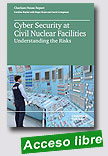 |
Cyber Security at Civil Nuclear Facilities - Understanding the Risks
Chatham House - Royal Institute of International Affairs, September 2015, 53 p.
Recent high-profile cyber attacks, including the deployment of the sophisticated 2010 Stuxnet worm, have raised new concerns about the cyber security vulnerabilities of nuclear facilities. As cyber criminals, states and terrorist groups increase their online activities, the fear of a serious
cyber attack is ever present. This is of particular concern
|
because of the risk – even if remote – of a release of ionizing radiation as a result of such an attack. Moreover, even a small-scale cyber security incident at a nuclear facility would be likely to have a disproportionate effect on public opinion and the future of the civil nuclear industry.
Notwithstanding important recent steps taken by the International Atomic Energy Agency (IAEA) to improve cyber security across the sector, the nuclear energy industry currently has less experience in this field than other sectors. This is partly due to the nuclear industry’s
regulatory requirements, which have meant that digital systems have been adopted later than in other types of critical infrastructure. In addition, the industry’s longstanding focus on physical protection and safety has meant that while these aspects of risk response are now relatively robust, less attention has been paid to developing cyber security readiness. As a result, exploiting weaknesses in digital technology could be the most attractive route for those seeking to attack nuclear facilities without fear of interdiction.
The cyber security risk is growing as nuclear facilities become increasingly reliant on digital systems and make increasing use of commercial ‘off-the-shelf’ software, which offers considerable cost savings but increases vulnerability to hacking attacks. The trend to digitization, when combined with a lack of executive-level awareness of the risks involved, also means that nuclear plant personnel may not realize the full extent of this cyber vulnerability and are thus inadequately prepared to deal with potential attacks. There is a pervading myth that nuclear facilities are ‘air gapped’ – or completely isolated from the public internet – and that this protects them from cyber attack.
Yet not only can air gaps be breached with nothing more than a flash drive (as in the case of Stuxnet), but the commercial benefits of internet connectivity mean that nuclear facilities may now have virtual priva e networks and other connections installed, sometimes undocumented or forgotten by contractors and other legitimate thirdparty operators.
Meanwhile, hacking is becoming ever easier to conduct, and more widespread: automatic cyber attack packages targeted at known and discovered vulnerabilities are widely available for purchase; advanced techniques used by Stuxnet are now known and being copied; and search engines can readily identify critical infrastructure components that are connected to the internet.
In the light of these concerns, Chatham House undertook an 18-month project in 2014–15 on the nexus between cyber security and nuclear security. By drawing on indepth interviews with 30 industry practitioners, as well as policy-makers and academics, and convening three expert roundtables, the project sought to assess the major cyber security challenges facing the wider nuclear industry; to identify international policy measures that could help to enhance cyber security in the sector; and to help increase knowledge of current concerns in this area. This report examines the major cyber threats to civil nuclear facilities, focusing in particular on those that could have an impact on industrial control systems, and suggests some potential solutions to these challenges.
Executive summary
Extraído de: https://www.chathamhouse.org/sites/files/
chathamhouse/field/field_document/20151005
CyberSecurityNuclearBaylonBruntLivingstoneExecSum.pdf
|
 |
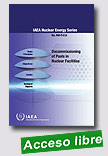 |
Decommissioning of Pools in Nuclear Facilities
IAEA Nuclear Energy Series, 2015, 197 p
Pools or ponds are usually an integrated part of a more complex nuclear facility, but in some particular cases pools may be considered as a separate nuclear facility with a specific license. A number of nuclear installations utilize pools for the cooling of spent fuel, or the shielding of research reactor cores or irradiator sources. Over a service lifetime that can span decades, nuclear pools may become contaminated as a result of the deposition of radioactive substances.
|
Relevant aspects of pool decommissioning covered in this publication include project planning and management, health and safety, and the management of resulting waste.
Extraído de: http://www-pub.iaea.org/books/IAEABooks/10669/Decommissioning-of-Pools-in-Nuclear-Facilities
|
 |
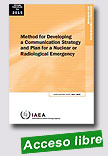 |
The objective of this publication is to provide national and local authorities with guidance on developing a national and local radiation emergency communication plan (RECP). It should be noted at the outset that such a plan is intended to document the specific functions, arrangements and capabilities that will be required for public communication during a radiation emergency. Critical tasks for the communication response function are set out in EPR-Method 2003 and in
|
Communication with the Public in a Nuclear or Radiological Emergency (EPR-Public Communication 2012), and are consistent with the relevant IAEA safety standards. These critical tasks adress providing information and issuing instructions to the public and keeping the public informed.
This publication provides an adaptable template that can be used by those responsible for public communication in Member States to develop a RECP. It is intended to support the development of communication plans and arrangements of all the responding or involved organizations and their relationships, as described in EPR-Public Communications 2012.
The resulting RECP will need to be consistent with the national radiation emergency plan (NREP), wich is a description of all roles and responsibilities in the overall response to a radiation emergency. The template may be adapted where necessary to reflect the structure of any existing national emergency response plan as long as the different prescribed sections are captured.
Extraído de: http://www-pub.iaea.org/books/IAEABooks/10866/Method-for-Developing-a-Communication-Strategy-and-Plan-for-a-Nuclear-or-
Radiological-Emer |
 |
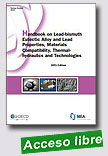 |
Handbook on Lead-bismuth Eutectic Alloy and Lead Properties, Materials Compatibility, Thermal-hydraulics and Technologies
Nuclear Energy Agency (NEA), 11/08/15, 954 p.
Heavy liquid metals such as lead or lead-bismuth have been proposed and investigated as coolants for fast reactors since the 1950s. More recently, there has been renewed interest worldwide in the use of these materials to support the development of systems for the transmutation of radioactive waste. Heavy liquid metals are also under evaluation as a
|
reactor core coolant and accelerator-driven system neutron spallation source. Several national and international R&D programmes are ongoing for the development of liquid lead-alloy technology and the design of liquid-lead alloy-cooled reactor systems.
In 2007, a first edition of the handbook was published to provide deeper insight into the properties and experimental results in relation to lead and lead-bismuth eutectic technology and establish a common database. This handbook remains a reference and is a valuable tool for designers and researchers with an interest in heavy liquid metals.
The 2015 edition includes updated data resulting from various national and international R&D programmes and contains new experimental data to help understand some important phenomena such as liquid metal embrittlement and turbulent heat transfer in a fuel bundle. The handbook provides an overview of liquid lead and lead-bismuth eutectic properties, materials compatibility and testing issues, key aspects of thermal-hydraulics and existing facilities, as well as perspectives for future R&D.
Extraído de: http://www.oecdnea.org/tools/publication?query=&div=
&lang=&period=6m&sort=title&filter=1#p7268
|
 |
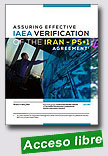
|
Assuring Effective IAEA Verification of the Iran - P5+1 Agreement
Search for Common Ground, Princeton University, July 2015, 64 p.
On July 14, 2015, the United States, China, France, Germany, Russia and the United Kingdom concluded a Joint Comprehensive Plan of Action (JCPOA) with Iran. Under this Plan, Iran will limit its nuclear program so as to maximize the warning time the international community would have if Iran decided to develop nuclear weapons. Iran also will accept |
enhanced IAEA monitoring so that the international community will be able to know whether or not Iran is living up to its agreements. Iran also has committed to respond promptly to the IAEA’s questions about past activities that suggest that Iran was exploring the development of nuclear weapons. Assuming the Director General reaches a favorable finding, the sanctions imposed on Iran will be phased out as Iran implements the terms of the agreement.
Extraído de: https://www.sfcg.org/new-study-likelihood-of-success-of-new-iran-nuclear-deal/
|
 |
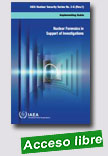 |
Nuclear Forensics in Support of Investigations
IAEA Nuclear Security Series, 2015, 80 p.
This publication is a revision of IAEA Nuclear Security Series No. 2, Nuclear Forensics Support, which was published in 2006. Since then, there has been substantive expansion and confidence in the application of nuclear forensics globally to effectively counter the threat of nuclear and other radioactive materials out of regulatory control. Most significantly, nuclear forensics has been applied in response to a number of incidents involving the illicit trafficking of highly enriched
|
uranium and plutonium. The essential lessons learned from these experiences are incorporated in the revised publication to update the procedures and methods used in the conduct of a nuclear forensic examination as well as stress the importance of international cooperation.
Extraído de: http://www-pub.iaea.org/books/IAEABooks/10797/Nuclear-Forensics-in-Support-of-Investigations
|
 |
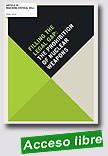 |
Filling the Legal Gap: the Prohibition of Nuclear Weapons
Women's International League for Peace and Freedom (WILPF), April 2015, 4 p.
This table overleaf from Reaching Critical Will and Article 36 summaries the gaps in existing treaty law related to nuclear weapons that could be filled by a treaty banning nuclear weapons.
The “legal gap” regarding prohibition and elimination arises from various deficits in the regulation of activities involving nuclear weapons, as currently codified. The key “legal gap” that
|
needs to be filled is the explicit prohibition of nuclear weapons and establishment of a framework for their elimination. A treaty banning nuclear weapons, by categorically prohibiting nuclear weapons and establishing a framework and impetus for their elimination, would help to fill these gaps. The other weapons of mass destruction, biological and chemical weapons, are prohibited and subject to elimination processes through international legal instruments. It is past time that nuclear weapons are put on the same legal footing
Extraído de: http://www.reachingcriticalwill.org/resources/publications-and-research/publications/9730-filling-the-legal-gap-the-prohibition-of-nuclear-weapons
|
 |
|

|
Country Nuclear Power Profiles - 2015 Edition
IAEA Non-serial Publications, CD-ROM, 2015, s. p.
The Country Nuclear Power Profiles compile background information on the status and development of nuclear power programmes in Member States. The publication summarizes organizational and industrial aspects of nuclear power programmes and provides information about the relevant legislative, regulatory and international framework in each State. Its descriptive and statistical overview of the overall economic, energy and electricity situation in each State and its
|
nuclear power framework is intended to serve as an integrated source of key background information about nuclear power programmes throughout the world. This 2015 edition, issued on CD-ROM, contains updated country information for 51 States.
Extraído de: http://www-pub.iaea.org/books/IAEABooks/10971/Country-Nuclear-Power-Profiles-2015-Edition
|
 |
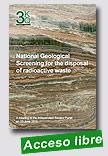 |
National Geological Screening for the Disposal of Radioactive Waste: Report of the Independent Review Panel Meeting on 23 June 2015
Nuclear Decommissioning Authority (NDA - UK), 29 July 2015, 18 p.
A report on the recent meeting between the Independent Review Panel (IRP) and RWM has been compiled by the independent facilitators of the meeting, 3KQ. The meeting was held at the British Academy, London, on 23 June 2015 and part of the National Geological Screening (NGS) exercise.
This report aims to capture as closely as possible the
|
essence of a roundtable discussion between the IRP and RWM. The reporting style chosen therefore strikes a balance between reproducing verbatim what each person said and providing an accessible and useful written summary of the discussion.
Extraído de: http://www.nda.gov.uk/publication/national-geological-screening-for-the-disposal-of-radioactive-waste-2/ |
| |
| |
|
|
| |
| |
|
|
| |
| |
|
|
| |
|
|
|
|
|
